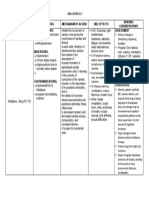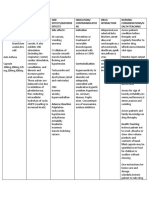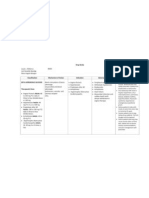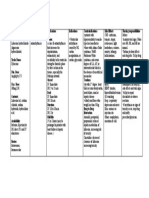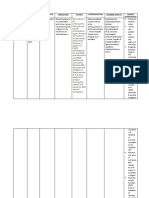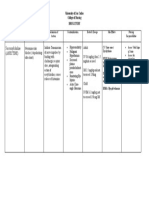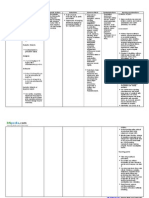Drug Study Pethidine
Drug Study Pethidine
Uploaded by
rica sebabillonesCopyright:
Available Formats
Drug Study Pethidine
Drug Study Pethidine
Uploaded by
rica sebabillonesCopyright
Available Formats
Share this document
Did you find this document useful?
Is this content inappropriate?
Copyright:
Available Formats
Drug Study Pethidine
Drug Study Pethidine
Uploaded by
rica sebabillonesCopyright:
Available Formats
PHINMA - UNIVERSITY OF ILOILO
COLLEGE OF ALLIED HEALTH SCIENCES
Nursing Department
DRUG STUDY
THERAPEUTIC NURSING
MEDICATION INDICATIONS CONTRAINDICATIONS SIDE EFFECTS
ACTIONS RESPONSIBILITIES/PRECAUTIONS
GENERIC NAME: Similar to other narcotics, Indicated for the Use of pethidine should be Like other opioids, -Assess need for naloxone upon initiating and
Pethidine meperidine management of acute avoided in patients with diabetic pethidine is renewing treatment
causes respiratory pain severe enough to acidosis where there is danger of associated with -Consult patients and caregivers on the
BRAND NAME: depression and require an opioid coma. It also contra-indicated in several side effects, availability of naloxone for emergency treatment
Demerol, pethidine suppresses the cough analgesic. conditions associated with raised including nausea, of opioid overdose.
reflex. The sedative and intracranial pressure and in head vomiting, dizziness, -Because of risks of addiction, abuse, and misuse
CLASSIFICATION: analgesic effects of injury (opioid analgesics interfere drowsiness and with opioids, even at recommended doses,
Opioid Analgesics; meperidine after with pupillary responses vital for confusion. One study reserve therapy for use in patients for whom
Synthetic, Opioids intravenous dosing occur neurological assessment). found that when alternative treatment options
within 2 to 4 minutes, compared to -Monitor patients with a history of seizure
and the analgesic effects tramadol, pethidine disorders for worsened seizure control during
ROUTE:
can last 4 hours. caused more nausea, DEMEROL Tablets and Oral Solution therapy.
Pethidine Injection may
vomiting and Prolonged meperidine use may increase the risk
be administered by
drowsiness in full- of toxicity (e.g., seizures)
subcutaneous,
term parturients.
intramuscular or slow
intravenous injection.
DOSAGE/FREQUENCY:
Adult:
50 mg to 150 mg orally,
every 3 or 4 hours as
needed for pain
Pediatric Patients:
1.1 mg/kg to 1.8 mg/kg
orally, up to the adult
dose, every 3 or 4 hours
as necessary
PREPARED BY: Billones, Rica S.
CLINICAL INSTRUCTOR:
You might also like
- LabetalolDocument3 pagesLabetalolTri Purma Sari50% (2)
- Pharma Lecture FinalDocument75 pagesPharma Lecture Finalibriane eveNo ratings yet
- Drug Study MetoclopramideDocument2 pagesDrug Study Metoclopramiderica sebabillones100% (2)
- OfloxacinDocument2 pagesOfloxacinCarla Arciaga100% (1)
- Aminophylline Drug StudyDocument1 pageAminophylline Drug StudyEmman Balido67% (3)
- Drug Study - Nifedipine PODocument1 pageDrug Study - Nifedipine POJet BautistaNo ratings yet
- 4 Reconstitution of Powdered Drugs1 PDFDocument6 pages4 Reconstitution of Powdered Drugs1 PDFJB Reyes100% (1)
- Ancef Drug CardDocument1 pageAncef Drug CardSheri490No ratings yet
- Drug Sudy Format MethyldopaDocument3 pagesDrug Sudy Format MethyldopaBianca Marithè RejanoNo ratings yet
- SHEENA Clomid Drug StudyDocument3 pagesSHEENA Clomid Drug StudyNur SetsuNo ratings yet
- ChlorphenamineDocument1 pageChlorphenaminereinaNo ratings yet
- LABETALOL Drug StudyDocument2 pagesLABETALOL Drug StudyLeoNo ratings yet
- Drug Mode of Action Indication Adverse Effects Nursing Responsibilities Generic NameDocument3 pagesDrug Mode of Action Indication Adverse Effects Nursing Responsibilities Generic NameJinky Nacar DomingoNo ratings yet
- Drug Study HeparinDocument2 pagesDrug Study HeparinArianne Nicole100% (1)
- Clomid Drug StudyDocument3 pagesClomid Drug StudySheen Ivashkov-BelikovNo ratings yet
- Generic Name:: Norgestimate and Ethinyl EstradiolDocument5 pagesGeneric Name:: Norgestimate and Ethinyl EstradiolJay VillasotoNo ratings yet
- Drug Study Table OkDocument29 pagesDrug Study Table OkRifa'atul Mahmudah100% (1)
- Drug Study-MethyldopaDocument4 pagesDrug Study-MethyldopaJinnijinniNo ratings yet
- Labetalol Hydro ChlorideDocument3 pagesLabetalol Hydro Chlorideapi-3797941100% (1)
- Drug Study DinoprostoneDocument2 pagesDrug Study DinoprostoneMva AgueroNo ratings yet
- MedroxyprogesteroneDocument5 pagesMedroxyprogesteroneunkown userNo ratings yet
- Drug Study LabetalolDocument2 pagesDrug Study LabetalolJanzelvine Lee MontenegroNo ratings yet
- Drug Study - Calcium GluconateDocument1 pageDrug Study - Calcium GluconatemikErlhNo ratings yet
- Nifedipine Drug StudyDocument3 pagesNifedipine Drug StudyCrystal Queen MarquezNo ratings yet
- Drug StudyDocument1 pageDrug StudyPRINCESS MARIZHAR OMARNo ratings yet
- THEOPHYLLINE - Drug StudyDocument2 pagesTHEOPHYLLINE - Drug Studyeric macabiogNo ratings yet
- NitroglycerinDocument3 pagesNitroglycerinFreisanChenMandumotanNo ratings yet
- Drug Study Number 3 Repro.,respi and GastrointestinalDocument64 pagesDrug Study Number 3 Repro.,respi and Gastrointestinaljamaica cabrigaNo ratings yet
- Drug Study PrednisoloneDocument2 pagesDrug Study Prednisoloneunnamed personNo ratings yet
- RitodrineDocument4 pagesRitodrineMariquita BuenafeNo ratings yet
- Drug Study MisoprostolDocument2 pagesDrug Study Misoprostolrica sebabillones50% (2)
- Drug Study Beta BlockersDocument2 pagesDrug Study Beta BlockersDan Mandig100% (1)
- Dexamethasone Drug StudyDocument2 pagesDexamethasone Drug StudyVIDMENTON PHNo ratings yet
- Nifedipine Drug StudyDocument2 pagesNifedipine Drug StudyMary Shane MoraldeNo ratings yet
- Drug Study Dopamine HCLDocument2 pagesDrug Study Dopamine HCLA.100% (1)
- GLYBURIDEDocument2 pagesGLYBURIDEanne marieNo ratings yet
- HydrochlorothiazideDocument2 pagesHydrochlorothiazidekuro hanabusa100% (1)
- INDOMETACINDocument5 pagesINDOMETACINteslimolakunlerajiNo ratings yet
- Drug Study MisoprostolDocument2 pagesDrug Study Misoprostolrica sebabillones100% (1)
- Drug Study SulfasalazineDocument2 pagesDrug Study SulfasalazineBunnie AlphaNo ratings yet
- Name of Drug Generic (Brand) Classification Dose/ Frequency/ Route Mechanism of Action Indication Contraindication Side Effects Nursing PrecautionDocument1 pageName of Drug Generic (Brand) Classification Dose/ Frequency/ Route Mechanism of Action Indication Contraindication Side Effects Nursing PrecautionJulia Shane Barrios100% (1)
- BNP (C)Document2 pagesBNP (C)Mae Ann Bueno CastillonNo ratings yet
- Drug Classification Action of Drug Indication and Contraindication Side Effect Nursing ConsiderationDocument2 pagesDrug Classification Action of Drug Indication and Contraindication Side Effect Nursing ConsiderationDanica Kate GalleonNo ratings yet
- EstradiolDocument1 pageEstradiol3S - JOCSON, DENESE NICOLE LEE M.No ratings yet
- Generic NameDocument6 pagesGeneric NameKimsha ConcepcionNo ratings yet
- UROKINASE (Kinlytic)Document4 pagesUROKINASE (Kinlytic)Mikaela Gabrielle GeraliNo ratings yet
- Drug StudyDocument5 pagesDrug StudyGAYOL BREEN IRAH A.No ratings yet
- XylocaineDocument1 pageXylocaineRozanne BanzaliNo ratings yet
- Drug StudyDocument3 pagesDrug Studyunkown userNo ratings yet
- Mindanao State University - Iligan Institute of Technology Student: Section: 263Document2 pagesMindanao State University - Iligan Institute of Technology Student: Section: 263AkiraMamo100% (1)
- Drug Name Indication Action Adverse EffectsDocument4 pagesDrug Name Indication Action Adverse EffectsMaryjoy Gabriellee De La CruzNo ratings yet
- Calcium GluconateDocument2 pagesCalcium GluconateMae Ann Bueno Castillon100% (1)
- Drug Study MethergineDocument2 pagesDrug Study MethergineJahmil DulatreNo ratings yet
- PHENYLEPHRINEDocument3 pagesPHENYLEPHRINERoger Jr PumarenNo ratings yet
- Drug Study Amoxicillin PDFDocument4 pagesDrug Study Amoxicillin PDFMc SantosNo ratings yet
- Drug Study OxytocinDocument2 pagesDrug Study Oxytocinrica sebabillonesNo ratings yet
- Succunylcholine (Anectine) : University of San Carlos College of Nursing Drug StudyDocument1 pageSuccunylcholine (Anectine) : University of San Carlos College of Nursing Drug StudyFederico AndalesNo ratings yet
- Drug Study-Nifedipine-BALLON, Karlo C.Document2 pagesDrug Study-Nifedipine-BALLON, Karlo C.Melinda Cariño Ballon100% (1)
- Trandate (Labetalol)Document3 pagesTrandate (Labetalol)ENo ratings yet
- EsmololDocument3 pagesEsmololTri Purma SariNo ratings yet
- Codeine Phosphate (Drug Study)Document2 pagesCodeine Phosphate (Drug Study)Franz.thenurse6888100% (2)
- TerbutalineDocument1 pageTerbutalineRyan Paul Balot0% (1)
- Epirubicin 10Document1 pageEpirubicin 10PdianghunNo ratings yet
- Drug Study of OpioidDocument3 pagesDrug Study of OpioidGerrahNo ratings yet
- When A Disease Is The Result of A Combination of Genes, It Is Called?Document2 pagesWhen A Disease Is The Result of A Combination of Genes, It Is Called?rica sebabillonesNo ratings yet
- Q and A FINALDocument31 pagesQ and A FINALrica sebabillonesNo ratings yet
- CHN 2 Session 2 SASDocument6 pagesCHN 2 Session 2 SASrica sebabillonesNo ratings yet
- Rationalization Activity 20Document3 pagesRationalization Activity 20rica sebabillonesNo ratings yet
- CHN 2 Session 5 SASDocument11 pagesCHN 2 Session 5 SASrica sebabillonesNo ratings yet
- Rationalization Activity 23Document2 pagesRationalization Activity 23rica sebabillonesNo ratings yet
- Rationalization Activity 18Document3 pagesRationalization Activity 18rica sebabillonesNo ratings yet
- Insecurities and Disappoint Ments: Setting Aside My Addiction On Korean Dramas and Online GamesDocument3 pagesInsecurities and Disappoint Ments: Setting Aside My Addiction On Korean Dramas and Online Gamesrica sebabillonesNo ratings yet
- Sas 14 Nur 145 - Wps OfficeDocument3 pagesSas 14 Nur 145 - Wps Officerica sebabillonesNo ratings yet
- Drug Study MisoprostolDocument2 pagesDrug Study Misoprostolrica sebabillones100% (1)
- Biochemistry Lab Hand OutsDocument12 pagesBiochemistry Lab Hand Outsrica sebabillonesNo ratings yet
- Drug Study OxytocinDocument2 pagesDrug Study Oxytocinrica sebabillonesNo ratings yet
- Drug Study RopivacaineDocument2 pagesDrug Study Ropivacainerica sebabillonesNo ratings yet
- Misappropriation: A. Slander B. LibelDocument3 pagesMisappropriation: A. Slander B. Libelrica sebabillonesNo ratings yet
- Drug Study: Nursing DepartmentDocument2 pagesDrug Study: Nursing Departmentrica sebabillones100% (1)
- Drug Study MisoprostolDocument2 pagesDrug Study Misoprostolrica sebabillones50% (2)
- Sas 5 Nur 145-Wps OfficeDocument2 pagesSas 5 Nur 145-Wps Officerica sebabillonesNo ratings yet
- Micro Lec Ars Sessions 17 23Document9 pagesMicro Lec Ars Sessions 17 23rica sebabillonesNo ratings yet
- Rationalization Sas 7Document2 pagesRationalization Sas 7rica sebabillonesNo ratings yet
- NUR 104 Health Care Ethics Rationalization Activity Session 5Document2 pagesNUR 104 Health Care Ethics Rationalization Activity Session 5rica sebabillonesNo ratings yet
- Rationalization Sas 6Document3 pagesRationalization Sas 6rica sebabillonesNo ratings yet
- NUR 104 Health Care Ethics Rationalization Activity Session 4Document3 pagesNUR 104 Health Care Ethics Rationalization Activity Session 4rica sebabillonesNo ratings yet
- Bioethics Rationalization Activity 2Document3 pagesBioethics Rationalization Activity 2rica sebabillonesNo ratings yet
- Micro Lec A&rs Sessions 9 - 16Document16 pagesMicro Lec A&rs Sessions 9 - 16rica sebabillonesNo ratings yet
- Sas 11 Nur 145 - Wps OfficeDocument2 pagesSas 11 Nur 145 - Wps Officerica sebabillonesNo ratings yet
- To To: OfficeDocument9 pagesTo To: Officeironmanmk6No ratings yet
- Generic LabelingDocument18 pagesGeneric LabelingAlex JayNo ratings yet
- Emea Allergic Rhino-ConjunctiviitisDocument9 pagesEmea Allergic Rhino-Conjunctiviitiswmmaster2014No ratings yet
- Generik FormulariumDocument22 pagesGenerik FormulariumWinda NingsihNo ratings yet
- Global Rheumatoid Arthritis Drugs MarketDocument2 pagesGlobal Rheumatoid Arthritis Drugs MarketiHealthcareAnalyst, Inc.No ratings yet
- Imp of Pharmacology: Batch: 2K19 Batch: 2K19 Batch: 2K19 Batch: 2K19 (HMT.) (HMT.) (HMT.) (HMT.)Document12 pagesImp of Pharmacology: Batch: 2K19 Batch: 2K19 Batch: 2K19 Batch: 2K19 (HMT.) (HMT.) (HMT.) (HMT.)movies linkNo ratings yet
- ADR FormDocument2 pagesADR FormSachin Jadon0% (1)
- Effects of Tropicamide and Phenylephrine On Iris Dilation and Blood Pressure in Adults With and Without HypertensionDocument5 pagesEffects of Tropicamide and Phenylephrine On Iris Dilation and Blood Pressure in Adults With and Without Hypertensionnur zalenaNo ratings yet
- Mw2 Drug StudyDocument2 pagesMw2 Drug Studyc.cagas.529054No ratings yet
- Lithium Treatment OSCEDocument2 pagesLithium Treatment OSCEmstudent1986No ratings yet
- Pharmacology Prelim TransesDocument12 pagesPharmacology Prelim TransesMarth Jasmine M. AllejosNo ratings yet
- Anticoag CompetencyDocument6 pagesAnticoag Competencyapi-587439953No ratings yet
- Daftar Obat Kapal REKOMENDASI WHO 3RD Rev KKP SemarangDocument1 pageDaftar Obat Kapal REKOMENDASI WHO 3RD Rev KKP Semaranganon_914901469100% (2)
- Sociodemographic Profile and Pattern of Drug Abuse Among Patients Presenting To A Deaddiction Centre in Rural Area of PunjabDocument5 pagesSociodemographic Profile and Pattern of Drug Abuse Among Patients Presenting To A Deaddiction Centre in Rural Area of PunjabRipudaman SinghNo ratings yet
- Drug Mechanism of Action/side Effects Indication/ Contraindication Nursing ResponsibilitiesDocument1 pageDrug Mechanism of Action/side Effects Indication/ Contraindication Nursing ResponsibilitiesSheryhan Tahir BayleNo ratings yet
- Tabela Agosto 2023Document10 pagesTabela Agosto 2023falcessonealvesNo ratings yet
- BP404T, PHarmacology I, Unit 1Document176 pagesBP404T, PHarmacology I, Unit 1Rajni YadavNo ratings yet
- Epo Rsud 2020Document45 pagesEpo Rsud 2020vera arimbiNo ratings yet
- Pho Meds ListDocument1 pagePho Meds Listmister emdiNo ratings yet
- Notes On Pharmacy Services On NC 2Document57 pagesNotes On Pharmacy Services On NC 2Mary Angelique BanogonNo ratings yet
- K335 - Yvt019 2Document33 pagesK335 - Yvt019 2ryan permadiNo ratings yet
- Benzos Factsheet2011Document4 pagesBenzos Factsheet2011tech1322No ratings yet
- Sie HR Brochure en Malta 2019 WebDocument7 pagesSie HR Brochure en Malta 2019 WebJustiniano D'SilvaNo ratings yet
- Drug and Alcohol AbuseDocument18 pagesDrug and Alcohol AbuseSanskriti Jain100% (1)
- Neurobiology and Neuroprotective Benefits of Sleep.4 PDFDocument23 pagesNeurobiology and Neuroprotective Benefits of Sleep.4 PDFchanguito17No ratings yet
- Phenobarbital Risk For Injury EAMCDocument4 pagesPhenobarbital Risk For Injury EAMCkeitacNo ratings yet
- CPR SummaryDocument2 pagesCPR SummaryaqsamerajNo ratings yet





